Financial Accounting Principles | Report
Added on 2020-02-03
41 Pages6450 Words41 Views
FINANCIAL ACCOUNTING
PRINCIPLES
PRINCIPLES
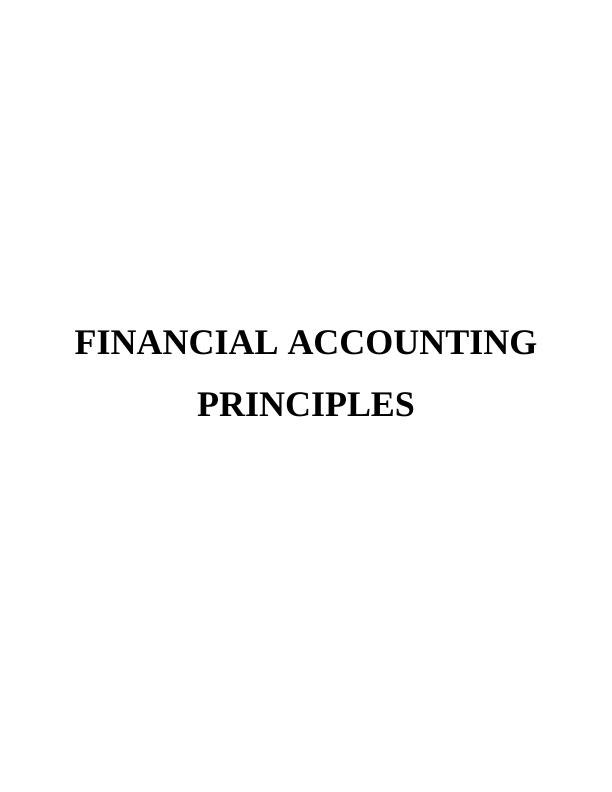
Table of Contents
INTRODUCTION...........................................................................................................................1
TASK 1............................................................................................................................................1
(a) Meaning of financial accounting, regulation, rules and principles with effective concept
relating to consistency and material disclosure......................................................................1
(B) PORTFOLIO FOR A CLIENT.................................................................................................5
CLIENT 1........................................................................................................................................5
(i) The book of primary entry.................................................................................................5
(ii) Complete double entry system.........................................................................................6
..............................................................................................................................................11
..............................................................................................................................................12
..............................................................................................................................................13
..............................................................................................................................................15
..............................................................................................................................................17
..............................................................................................................................................17
(iii) Close accounts with drawing the trail balance..............................................................17
CLIENT 2......................................................................................................................................18
(a) Statement of profit and loss for Peter Pipe ....................................................................18
(b) Statement of financial position for Peter Pipe................................................................20
CLIENT 3......................................................................................................................................21
(a) Prepare the statement of profit and loss of Rain tree Ltd................................................21
(b) The statement of financial position ................................................................................21
(c) Explains the accounting concept of consistency and prudence......................................22
(d) Describes the purposes of depreciation in formulates accounting statements................23
CLIENT 4......................................................................................................................................24
(i) Prepare a bank reconciliation statement..........................................................................24
(ii)Prepare Kundal Ltd.'s updated cash book .......................................................................24
(iii) Prepare a bank reconciliation statement........................................................................24
CLIENT 5......................................................................................................................................26
(a) Prepare and balance in books of Henderson...................................................................26
INTRODUCTION...........................................................................................................................1
TASK 1............................................................................................................................................1
(a) Meaning of financial accounting, regulation, rules and principles with effective concept
relating to consistency and material disclosure......................................................................1
(B) PORTFOLIO FOR A CLIENT.................................................................................................5
CLIENT 1........................................................................................................................................5
(i) The book of primary entry.................................................................................................5
(ii) Complete double entry system.........................................................................................6
..............................................................................................................................................11
..............................................................................................................................................12
..............................................................................................................................................13
..............................................................................................................................................15
..............................................................................................................................................17
..............................................................................................................................................17
(iii) Close accounts with drawing the trail balance..............................................................17
CLIENT 2......................................................................................................................................18
(a) Statement of profit and loss for Peter Pipe ....................................................................18
(b) Statement of financial position for Peter Pipe................................................................20
CLIENT 3......................................................................................................................................21
(a) Prepare the statement of profit and loss of Rain tree Ltd................................................21
(b) The statement of financial position ................................................................................21
(c) Explains the accounting concept of consistency and prudence......................................22
(d) Describes the purposes of depreciation in formulates accounting statements................23
CLIENT 4......................................................................................................................................24
(i) Prepare a bank reconciliation statement..........................................................................24
(ii)Prepare Kundal Ltd.'s updated cash book .......................................................................24
(iii) Prepare a bank reconciliation statement........................................................................24
CLIENT 5......................................................................................................................................26
(a) Prepare and balance in books of Henderson...................................................................26
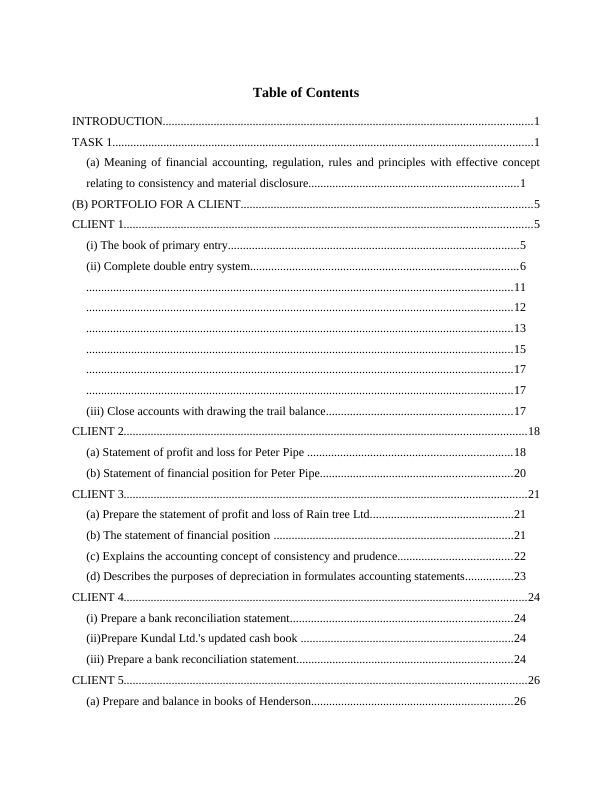
(i) Sales ledger control account ...........................................................................................26
(ii) Purchase ledger control account ....................................................................................27
(b) Control account ..............................................................................................................27
CLIENT 6......................................................................................................................................28
(a) Describes suspense account and main features of it.......................................................28
(b) Trial balance ..................................................................................................................29
(c) Journals entries with corrections.....................................................................................30
(d) Differentiate between suspense account and clearing account.......................................30
CONCLUSION..............................................................................................................................33
REFERENCES..............................................................................................................................34
(ii) Purchase ledger control account ....................................................................................27
(b) Control account ..............................................................................................................27
CLIENT 6......................................................................................................................................28
(a) Describes suspense account and main features of it.......................................................28
(b) Trial balance ..................................................................................................................29
(c) Journals entries with corrections.....................................................................................30
(d) Differentiate between suspense account and clearing account.......................................30
CONCLUSION..............................................................................................................................33
REFERENCES..............................................................................................................................34
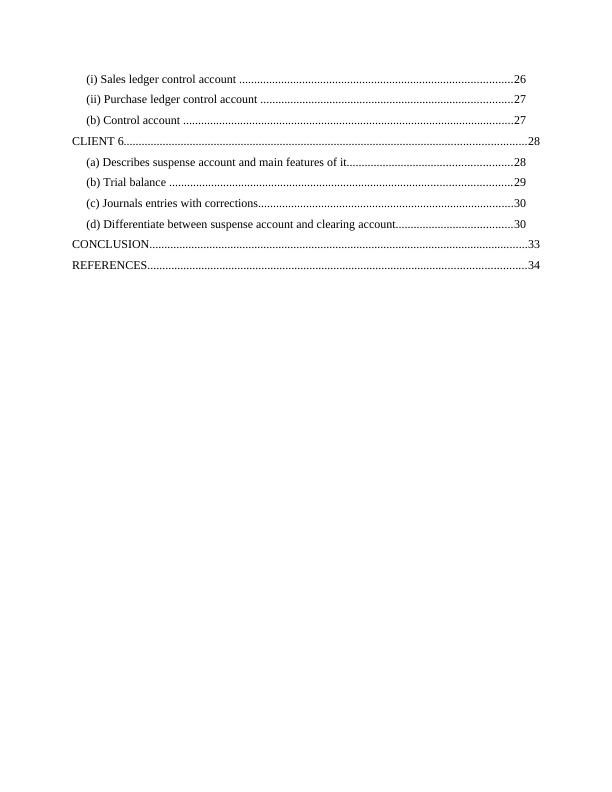
INTRODUCTION
In recent years, role of accounting is continuously increases which also enhance market
complexity. It includes generally accepted accounting principles which is common set of rules
and standards which indicates financial statements (Carmona, Ezzamel and Gutiérrez, 2016).
There are different types of companies exist in market which require financial statements as per
guidance of GAAP. Main aim to considering rules and regulation of GAAP to create standard
and uniform results that are based on financial outcomes and performances. With applying in
non profit organisation, transparency can be accomplish in easy way. It covers key areas such as
recognition, measurement, presentation and disclosure. These elements assist to minimize risk
from financial erroneous with reporting that assist to check and making safeguards in a place
(Michelon, Pilonato and Ricceri, 2015).
In this context, report is based on different clients of accounting firm who requires
prepares journal, ledger, profit and loss account, balance sheet and many other financial
statements. In addition to this, it is also induces rectification of errors which considers
rectification for accomplish transactions. With the help of following transactions, business can
revealed their conclusion towards decision and outcomes (Engel, 2016). Moreover, it stresses on
find out mistakes which occur in the enterprise to do transactions. In this aspect, different types
of objectives can be achieve by the company for ascertain financial statements at workplace.
TASK 1
(a) Meaning of financial accounting, regulation, rules and principles with effective concept
relating to consistency and material disclosure
Meaning of financial accounting: Financial accounting is special branch which keep all records
of financial transactions. It assists to using standardized principles and guidelines that are
recorded and summarized within financial report and statements. For example, income
statements and balance sheet (Rinaldi, Unerman and Tilt, 2014). In addition to this, financial
accounting is a crucial element which helpful to make routine schedule for solve company
issues. Statements considering externally because it can be given outside the firm such charted
accountant, etc.
Regulation that are related to financial accounting: In this aspect, principles are derived that
prepare for matching the concept. In a report of financial statements such as audit, compilation
1
In recent years, role of accounting is continuously increases which also enhance market
complexity. It includes generally accepted accounting principles which is common set of rules
and standards which indicates financial statements (Carmona, Ezzamel and Gutiérrez, 2016).
There are different types of companies exist in market which require financial statements as per
guidance of GAAP. Main aim to considering rules and regulation of GAAP to create standard
and uniform results that are based on financial outcomes and performances. With applying in
non profit organisation, transparency can be accomplish in easy way. It covers key areas such as
recognition, measurement, presentation and disclosure. These elements assist to minimize risk
from financial erroneous with reporting that assist to check and making safeguards in a place
(Michelon, Pilonato and Ricceri, 2015).
In this context, report is based on different clients of accounting firm who requires
prepares journal, ledger, profit and loss account, balance sheet and many other financial
statements. In addition to this, it is also induces rectification of errors which considers
rectification for accomplish transactions. With the help of following transactions, business can
revealed their conclusion towards decision and outcomes (Engel, 2016). Moreover, it stresses on
find out mistakes which occur in the enterprise to do transactions. In this aspect, different types
of objectives can be achieve by the company for ascertain financial statements at workplace.
TASK 1
(a) Meaning of financial accounting, regulation, rules and principles with effective concept
relating to consistency and material disclosure
Meaning of financial accounting: Financial accounting is special branch which keep all records
of financial transactions. It assists to using standardized principles and guidelines that are
recorded and summarized within financial report and statements. For example, income
statements and balance sheet (Rinaldi, Unerman and Tilt, 2014). In addition to this, financial
accounting is a crucial element which helpful to make routine schedule for solve company
issues. Statements considering externally because it can be given outside the firm such charted
accountant, etc.
Regulation that are related to financial accounting: In this aspect, principles are derived that
prepare for matching the concept. In a report of financial statements such as audit, compilation
1
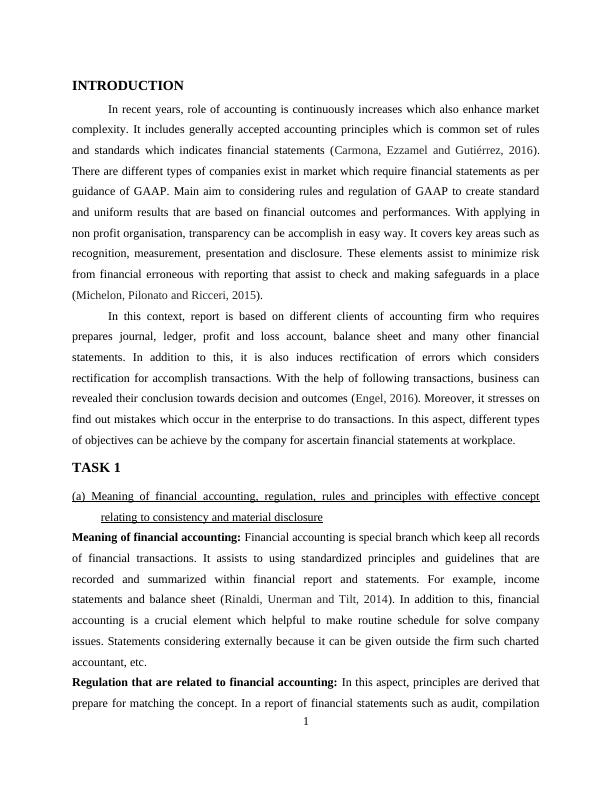
and review, etc. (Spence and Rinaldi, 2014). must be demonstrate information that are related to
contained statements of GAAP. There are certain regulation frames that are related to financial
accounting. They are as follows:
Principle of regularity: This principle is determines conformity with ensure rules and
laws.
Principle of consistency: It is states that what businesses fixed for treatment for
accounting, it regularly runs in same way every year (Colasse and Durand, 2014).
Principles of non-compensation: In this aspect, business should follows all details of
the financial information which seek to compensate a debt with an asset, revenue and
expenses, etc.
Principle of sincerity: This accounting principle is based on accounting unit which
reflect to good faith as per reality of financial status of company.
Principles of permanence of methods: This principle has aim to allowing and
comparing information that are related to finance part and also published by the
enterprise (Ahmad and Leftesi, 2014).
Principle of prudence: This principle has aim to show reality to make things look good
than they exist. In addition to this, revenue need to be recorded only when it covered in
certain provision with including for an expense.
Principle of continuity: In order to stating financial information, one person need to be
assume that enterprise cannot be interrupted. This principle ensures that assets have not
been accounted as disposable value which continually accounted which accepted on
historical value. For example, deprecation is considering as going concern (Miller and
Shawver, 2016).
Principle of periodicity: In respect to states financial information, accounting entry
allocating within a given period. It could be split as per covering various periods. In
addition to this, revenue also need to be split in the entire time span which not counted
for entire date of transaction.
Principle of full disclosure/materiality: With the help of information and value, it has
been pertaining that financial position in organisation need to be disclosed as records (de
Villiers, Rinaldi and Unerman, 2014).
2
contained statements of GAAP. There are certain regulation frames that are related to financial
accounting. They are as follows:
Principle of regularity: This principle is determines conformity with ensure rules and
laws.
Principle of consistency: It is states that what businesses fixed for treatment for
accounting, it regularly runs in same way every year (Colasse and Durand, 2014).
Principles of non-compensation: In this aspect, business should follows all details of
the financial information which seek to compensate a debt with an asset, revenue and
expenses, etc.
Principle of sincerity: This accounting principle is based on accounting unit which
reflect to good faith as per reality of financial status of company.
Principles of permanence of methods: This principle has aim to allowing and
comparing information that are related to finance part and also published by the
enterprise (Ahmad and Leftesi, 2014).
Principle of prudence: This principle has aim to show reality to make things look good
than they exist. In addition to this, revenue need to be recorded only when it covered in
certain provision with including for an expense.
Principle of continuity: In order to stating financial information, one person need to be
assume that enterprise cannot be interrupted. This principle ensures that assets have not
been accounted as disposable value which continually accounted which accepted on
historical value. For example, deprecation is considering as going concern (Miller and
Shawver, 2016).
Principle of periodicity: In respect to states financial information, accounting entry
allocating within a given period. It could be split as per covering various periods. In
addition to this, revenue also need to be split in the entire time span which not counted
for entire date of transaction.
Principle of full disclosure/materiality: With the help of information and value, it has
been pertaining that financial position in organisation need to be disclosed as records (de
Villiers, Rinaldi and Unerman, 2014).
2
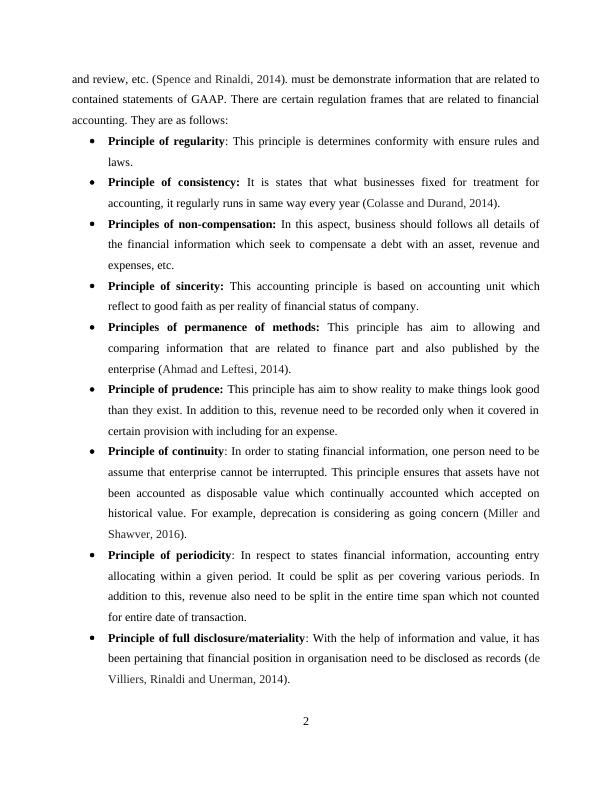
Principle of utmost good faith: All essential information that are related to the
enterprise also disclosed for insurer before taking policy.
Accounting rules and principles: Accounting principles are accepted in basically three
concepts such as basic accounting principles and guidelines, detailed rules and standards and
accepted rules by the industry (Vogel, 2014). Below are such accounting principles and
guidelines which is frames in GAAP: Economic entity assumption: This accounting principle keeps transaction of all
businesses ahead from owner of enterprise. The both are different entities which
considered in the market. Monetary unit assumption: Economic activity within the business is measuring in pound
and transaction are expressed in pound only (Pijper, 2016). The period assumption: This accounting principle determines complex activities in short
and distinctive term within a specific time interval. Cost principle: Cost is refers as amount which spent as cash or equivalent of it. In
addition to this, it demonstrates whether purchase has been happened last year of many
years ago (Ismail, Ramli and Darus, 2014). Full disclosure principle: In this principle, certain information need to be keep safe that
is important for an investor or lender. These types of informations need to be disclosed in
a statement in numerous financial attachments. Going concern principle: This accounting principle determines that the enterprise will
continue exist for long time that carry objectives and commitments that not liquidate in
foreseeable future (Dillard and Vinnari, 2017). Matching principle: This accounting principle is essential for the enterprises to using
accrual system. In this aspect, expenses are need to be match with revenue. For instance,
commission expense need to be reported within a period of sales is made. Wages of
employee is also reported as the expenses (Carmona, Ezzamel and Gutiérrez, 2016). Revenue recognition principles: As per the accrual basis accounting, revenue has been
recognized has been sold and services also performed with money that actually received. Materiality: This accounting principle is frame basic guidelines which need to be
followed by accountant. Professional judgement is also needed to demonstrate significant
amount (Laughlin, 2014).
3
enterprise also disclosed for insurer before taking policy.
Accounting rules and principles: Accounting principles are accepted in basically three
concepts such as basic accounting principles and guidelines, detailed rules and standards and
accepted rules by the industry (Vogel, 2014). Below are such accounting principles and
guidelines which is frames in GAAP: Economic entity assumption: This accounting principle keeps transaction of all
businesses ahead from owner of enterprise. The both are different entities which
considered in the market. Monetary unit assumption: Economic activity within the business is measuring in pound
and transaction are expressed in pound only (Pijper, 2016). The period assumption: This accounting principle determines complex activities in short
and distinctive term within a specific time interval. Cost principle: Cost is refers as amount which spent as cash or equivalent of it. In
addition to this, it demonstrates whether purchase has been happened last year of many
years ago (Ismail, Ramli and Darus, 2014). Full disclosure principle: In this principle, certain information need to be keep safe that
is important for an investor or lender. These types of informations need to be disclosed in
a statement in numerous financial attachments. Going concern principle: This accounting principle determines that the enterprise will
continue exist for long time that carry objectives and commitments that not liquidate in
foreseeable future (Dillard and Vinnari, 2017). Matching principle: This accounting principle is essential for the enterprises to using
accrual system. In this aspect, expenses are need to be match with revenue. For instance,
commission expense need to be reported within a period of sales is made. Wages of
employee is also reported as the expenses (Carmona, Ezzamel and Gutiérrez, 2016). Revenue recognition principles: As per the accrual basis accounting, revenue has been
recognized has been sold and services also performed with money that actually received. Materiality: This accounting principle is frame basic guidelines which need to be
followed by accountant. Professional judgement is also needed to demonstrate significant
amount (Laughlin, 2014).
3
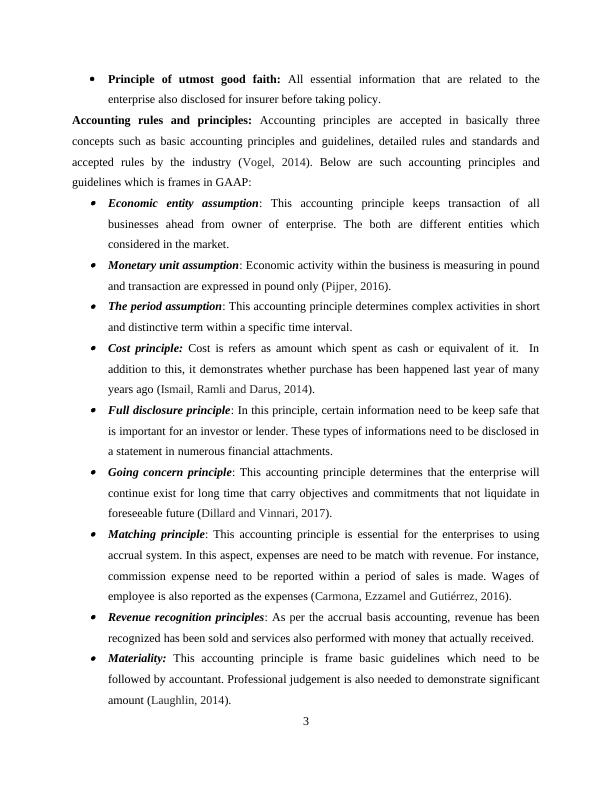
Conservatism: With this regard, two acceptable alternatives are exists within the
enterprise. Conservatism directs accountant for choosing the best alternative that take less
amount.
Conventions and concept relating to consistency and material disclosure: The term
convention includes costumes and tradition that guide accountant to prepare statements. There
are certain important accounting conventions: Convention of disclosure: In order to disclosure of all significant information, it is the
important accounting conventions (Zadek, Evans and Pruzan, 2013). It implies on
accounts which need to be prepare in a way which includes material information that is
clearly disclosed to the reader. Convention of materiality: Convention of materiality is refers as relative importance for
an item. In this convention, those events and items are recorded that possess significance
and other will be ignored. This is because, there is not any way which determines
difference between material and immaterial events (Youssef, 2015). Convention of consistency: This convention determines accounting practices which need
to be remains not charged from one time to another. For instance, stock is valued either
cost or market price whichever is less. Mainly this is follows after one year (Carmona,
Ezzamel and Gutiérrez, 2016).
Convention of conservatism: This element is based on caution approach that making
safe. It will ensure that uncertainties and risk element inherent in organisation activities
that has to be given in proper aspect (Ahmad, 2013).
4
enterprise. Conservatism directs accountant for choosing the best alternative that take less
amount.
Conventions and concept relating to consistency and material disclosure: The term
convention includes costumes and tradition that guide accountant to prepare statements. There
are certain important accounting conventions: Convention of disclosure: In order to disclosure of all significant information, it is the
important accounting conventions (Zadek, Evans and Pruzan, 2013). It implies on
accounts which need to be prepare in a way which includes material information that is
clearly disclosed to the reader. Convention of materiality: Convention of materiality is refers as relative importance for
an item. In this convention, those events and items are recorded that possess significance
and other will be ignored. This is because, there is not any way which determines
difference between material and immaterial events (Youssef, 2015). Convention of consistency: This convention determines accounting practices which need
to be remains not charged from one time to another. For instance, stock is valued either
cost or market price whichever is less. Mainly this is follows after one year (Carmona,
Ezzamel and Gutiérrez, 2016).
Convention of conservatism: This element is based on caution approach that making
safe. It will ensure that uncertainties and risk element inherent in organisation activities
that has to be given in proper aspect (Ahmad, 2013).
4

(B) PORTFOLIO FOR A CLIENT
CLIENT 1
(i) The book of primary entry
5
CLIENT 1
(i) The book of primary entry
5
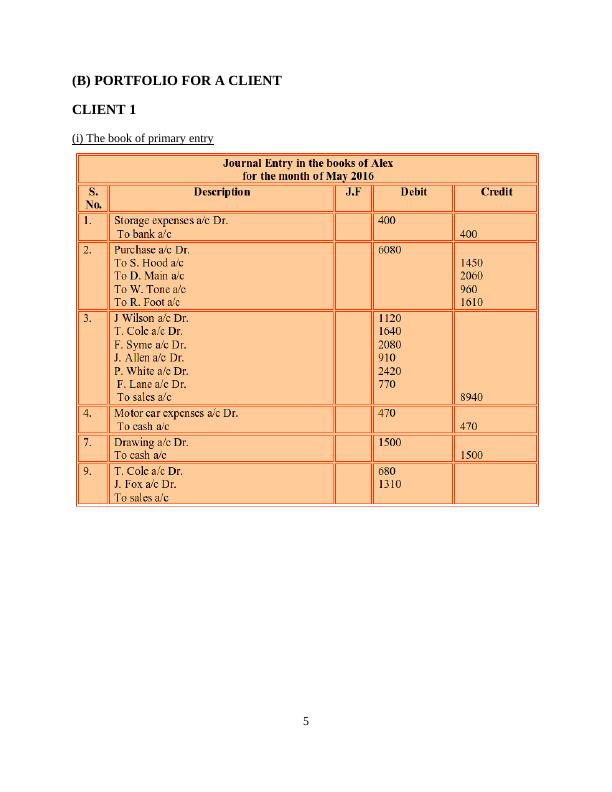
End of preview
Want to access all the pages? Upload your documents or become a member.
Related Documents
FINANCIAL ACCOUNTING INTRODUCTION 3 A. (A) Statement of financial position 20 (B)lg...
|30
|3307
|315
Introduction to Financial Accountinglg...
|30
|5105
|401
Financial Accounting Principles Assignment - Doclg...
|30
|7212
|286
Financial Accounting Assignment - Zync Solutionslg...
|29
|5360
|97
Financial Accounting Principles Assignment - RBS Accountants Ltdlg...
|26
|7021
|485
Accounting Principles Assignment | Financial Accounting Assignmentlg...
|32
|4628
|54
